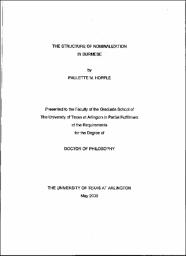
ATTENTION: The works hosted here are being migrated to a new repository that will consolidate resources, improve discoverability, and better show UTA's research impact on the global community. We will update authors as the migration progresses. Please see MavMatrix for more information.
Show simple item record
| dc.contributor.author | Hopple, Paulette M. | |
| dc.date.accessioned | 2020-10-12T14:45:14Z | |
| dc.date.available | 2020-10-12T14:45:14Z | |
| dc.date.issued | 2003-05 | |
| dc.identifier.uri | http://hdl.handle.net/10106/29511 | |
| dc.description.abstract | Nominalized sentential elements have long been observed in Tibeto-Burman languages, but the role and extent of nominalized patterns have not been explored as a base of formative structuring. This dissertation examines nominalization patterns in Burmese from the word to text level and posits a complex information packaging role of postposition particles in erecting a structure of predictable and iteratively patterned nominals which function to reduce information overload and facilitate online parsing. Burmese has been characterized as a predominantly verbal language (U Pe Maung Tin 1956). A complementary view is presented in which ontological objects created via a grammatical system of nominalization function to establish a sturdy skeletal framework for verbal and particle expression. Together the role of nominal and relational elements engender a balance realized structurally as ontological nominal objects whose juxtaposition iteratively creates larger nominals. The claim is made here that an underlying ontological level of organization supports grammatical categorization. This organization is structurally simple and patterned. Only two word categories are posited—noun and verb. A third basic category of postposition particle functions abstractly as a type of grammatical verb. The role of the particle is expanded as an abstract nominalizing element that constructs and organizes the ontological structure of Burmese sentences and orders higher level units of discourse. Sentences are regarded as nominalized units based upon the unique and diverse functions of sany as nominalizer. This key particle unlocks the role of nominalization in Burmese grammatical structure—as deictic specifier, as personalizer ‘affix’, as general nominal complementizer, as relativizer, and as sentence final particle of realis mood. The prototypical functions of sany are realized as a vast ‘conspiracy’ of nominalization underlying the organization of Burmese grammatical constructions from simple noun phrase to paragraph to the discourse as a whole. | en_US |
| dc.language.iso | en_US | en_US |
| dc.publisher | University of Texas at Arlington | en_US |
| dc.subject | Philosophy | en_US |
| dc.subject | Religion and theology | en_US |
| dc.subject | Language | en_US |
| dc.subject | Literature and linguistics | en_US |
| dc.subject | Burmese | en_US |
| dc.subject | Cognitive grammar | en_US |
| dc.subject | Nominalization | en_US |
| dc.subject | Ontology | en_US |
| dc.title | THE STRUCTURE OF NOMINALIZATION IN BURMESE | en_US |
| dc.type | Dissertation | en_US |
| thesis.degree.department | Linguistics | |
| thesis.degree.name | Doctor of Philosophy in Linguistics | |
Files in this item
- Name:
- The Structure of Nominalization ...
- Size:
- 15.74Mb
- Format:
- PDF
- Description:
- PDF
This item appears in the following Collection(s)
Show simple item record


